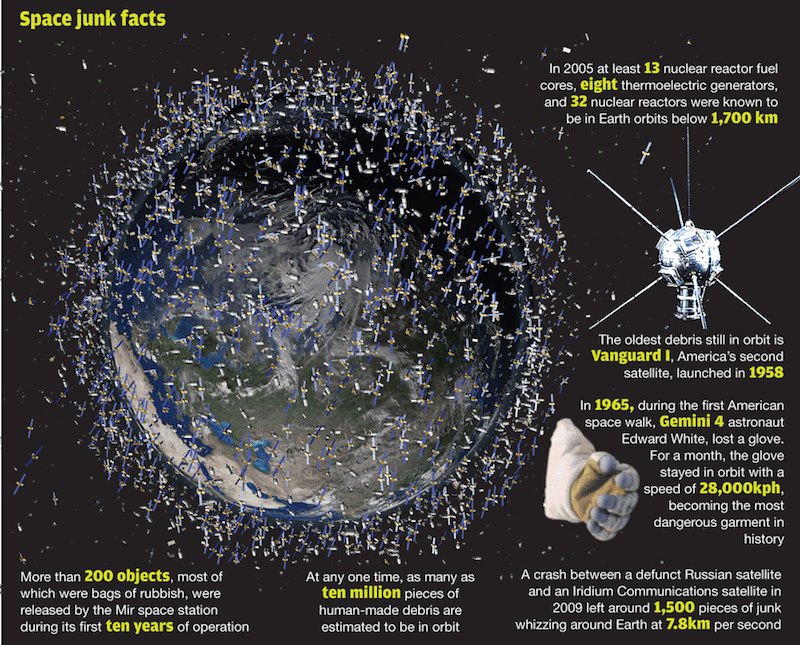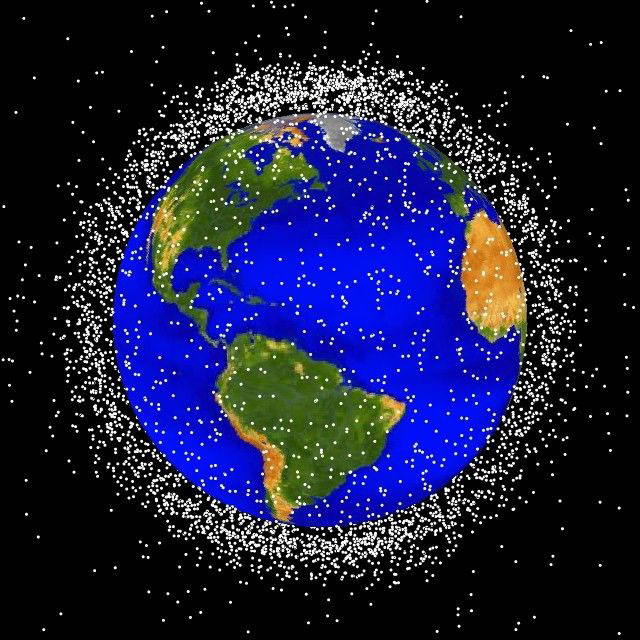Space Junk: Over 500,000 Tracked Pieces Overwhelms Capacity To Monitor And Warn
TMR Editor’s Report:
More than 500,000 pieces of debris, or “space junk,” are tracked as they orbit the Earth. They all travel at speeds up to 17,500 mph, fast enough for a relatively small piece of orbital debris to damage a satellite or a spacecraft.
(Source: Space Debris and Human Spacecraft)
The preceding quote comes from NASA’s own website at www.nasa.gov/mission so there is no mistaking the sheer volume of space junk that is being closely monitored. Of course, the obvious question is how effective can such a warning system really be when 500k plus pieces can move as fast as 17,500 miles per hour.
Space debris, also known as orbital debris, space junk and space waste, is the collection of manmade defunct objects in orbit around Earth. This includes spent rocket stages, old satellites and fragments from disintegration, erosion and collisions. Since orbits overlap with new spacecraft, debris may collide with operational spacecraft.
(Source: Space Debris)
The Chicken Littles of the future will be correct in warning humanity that the sky is falling. After all, the dated graphic above indicates that there are many as 10 million pieces of space junk orbiting Earth at any given time. That number may now be substantially higher given the marked increase in space endeavors now undertaken by nations across the planet.
In light of the fact that there are more and more very expensive and highly advanced satellites being launched by the year, it would seem necessary to reverse this trend to pollute space the same way that the human race has polluted the Earth’s surface. We are reminded of a quite prophetic warning offered by the Cosmic Convergence Research Group.
“When scientific knowledge and applied technology reach a critical level of advancement, without being informed by spiritual truths and guided by moral authority, the planetary civilization will relinquish its destiny to continue as it is.”
(Source: HUGE Changes Coming To Planet Earth)
Another prescient essay by the CCRG refers to the current age as one in which “common sense has become quite rare” and “the voice of reason has fled humankind”. In view of the following space debris visual, it appears that these statements from “The BIGGEST Coverup in USA History” are more accurate than ever.
What Obama and NASA don’t want you to know!
~~~~~~~~~~~~~~~~~~~~~~~~~~~~~~~~~~~~~~~~~~~~~~~~~~~~~~~~~~~~~~~~~~~~
Space Debris To Collide With Earth On Friday The 13th
But don’t worry.

According to the European Space Agency, something is going to fall to Earth on Friday, 13 November. A mysterious piece of space debris named WT1190F is predicted to re-enter the Earth’s atmosphere at around 06:20 GMT in the skies above the Indian Ocean. While it’s expected to burn up in the atmosphere about 100km off the south coast of Sri Lanka, it is not impossible that smaller fragments could crash onto the surface.The object must be the remains from a previous space mission, most likely a spent rocket from one of the recent robotic moon missions or even a relic from the Apollo era. But while it may seem like a bad omen, scientists are excited. It is notoriously difficult to predict exactly where debris that fall to the Earth will hit, so the opportunity to study the trajectory of WT1190F could help improve current methods.
A display of fireballs
The object was first spotted by the Catalina Sky Survey in 2013, swinging within 250,000km of the Earth before plunging back out into space to a distance of around half a million kilometers, twice as far away as the moon. But its elliptical orbit is unstable and the altitude of the object’s closest approach to the Earth has been falling. On Friday, this will cause it to dip into the atmosphere while moving at a speed of several kilometers per second. When this happens, atmospheric drag will slow it down and cause it to fall from orbit while the frictional effect of the air rushing past will pummel, heat and vaporize the object.
 Object WT1190F, the fast-moving white spot in the middle.
Object WT1190F, the fast-moving white spot in the middle.According to astronomers who have estimated its size and density, the object is about 1-2 meters in diameter and hollow. Luckily that means it is too small and fragile to be likely to make it to the surface. As it disintegrates, the smaller fragments will rapidly burn up creating a brilliant display of fireballs that may be visible streaking across the midday sky to the south of Sri Lanka. Only very small fragments, if anything, will splashdown in the Indian Ocean. There simply isn’t enough mass involved for this to be a cause for too much concern.We know this because it is by no means the first human-made object to fall from orbit, nor is it the largest. When the 135-tonne Russian Mir space station came to end of its life in 2001, most of the massive station vaporized during re-entry, some fragments fell harmlessly into the South Pacific Ocean.
The difficulty in predicting a crash site
However, it is not always easy to predict. When it became clear that NASA’s 75-tonne Skylab space station was going to re-enter the Earth’s atmosphere in July 1979, NASA estimated that the chances of a human being hit somewhere on the planet was one in 152.
Ultimately, instead of re-entering over the ocean south-east of South Africa while speeding eastwards, Skylab burned up slightly later than expected and fragments fell to Earth south-east of Perth, in Western Australia. While nobody was injured, Skylab’s demise highlighted uncertainties in the re-entry estimates of the day. Skylab turned out to be sturdier than expected, meaning the drag of the tumbling space station had been miscalculated.
 The 82 tonne Skylab space station re-entered the Earth’s atmosphere on 11th July 1979 and parts of it hit the Earth in Western Australia. Many large pieces were retrieved.
The 82 tonne Skylab space station re-entered the Earth’s atmosphere on 11th July 1979 and parts of it hit the Earth in Western Australia. Many large pieces were retrieved.Skylab also highlighted the important effect that mother nature has on such orbits. It had originally been thought that the space station, launched in May 1973, would remain in orbit for around nine years. But greater than expected solar activity in the 1970s resulted in increased heating and expansion of the Earth’s upper atmosphere. The resulting extra drag on the space station slowed it and caused its orbit to descend more quickly than predicted.Nowadays, the influence of solar activity of the near-Earth space environment is dubbed “space weather” and its impact on low-Earth orbiting objects is the focus of considerable research. As well as studying how it can increase the atmospheric drag on satellites and manned spacecraft, there is considerable interest in how it can alter the trajectory of space debris – a catch-all description that includes everything from rocket boosters and long-dead satellites to nuts and bolts. Surveys using ground-based radar have revealed more than 21,000 objects larger than 10cm in Earth orbit. Meanwhile, the estimated number of particles between 1cm and 10cm in diameter is about 500,000, while the number of particles smaller than 1cm runs into many millions.Being able to predict how the orbits of these objects will evolve is important to avoid future high-speed collisions between space debris and orbiting satellites or manned spacecraft. It is also vital to national defense agencies, who need to be able to discriminate between incoming space debris and inter-continental ballistic missiles.
But having filled the space surrounding our planet with an orbiting cloud of junk, best practiceis now to design an end-of-life “exit strategy” into modern satellites. Typically this involves a planned and controlled de-orbit, usually resulting in the complete destruction of the satellite in the upper atmosphere, or a planned maneuver into a stable graveyard orbit, tucked safely out of harm’s ways beyond geostationary orbit.
So should we be worried about WT1190F? No. Friday the 13th is going to be a bad day for that particular piece of space junk, but for researchers it’s a piece of good fortune. Simulations and predictions have come a long way since Skylab’s day and if the measurements made so far are correct, this is a relatively lightweight piece of debris and is very likely to burn up in a predictable fashion over in a well-defined area. Nevertheless, scientists will be monitoringWT1190F’s predicted re-entry zone carefully to gather data in an effort to improve our understanding of the physics of re-entry even further.
This story was originally published by The Conversation.
http://theconversation.com/space-junk-will-crash-back-to-earth-on-friday-the-13th-but-its-no-bad-omen-50611

